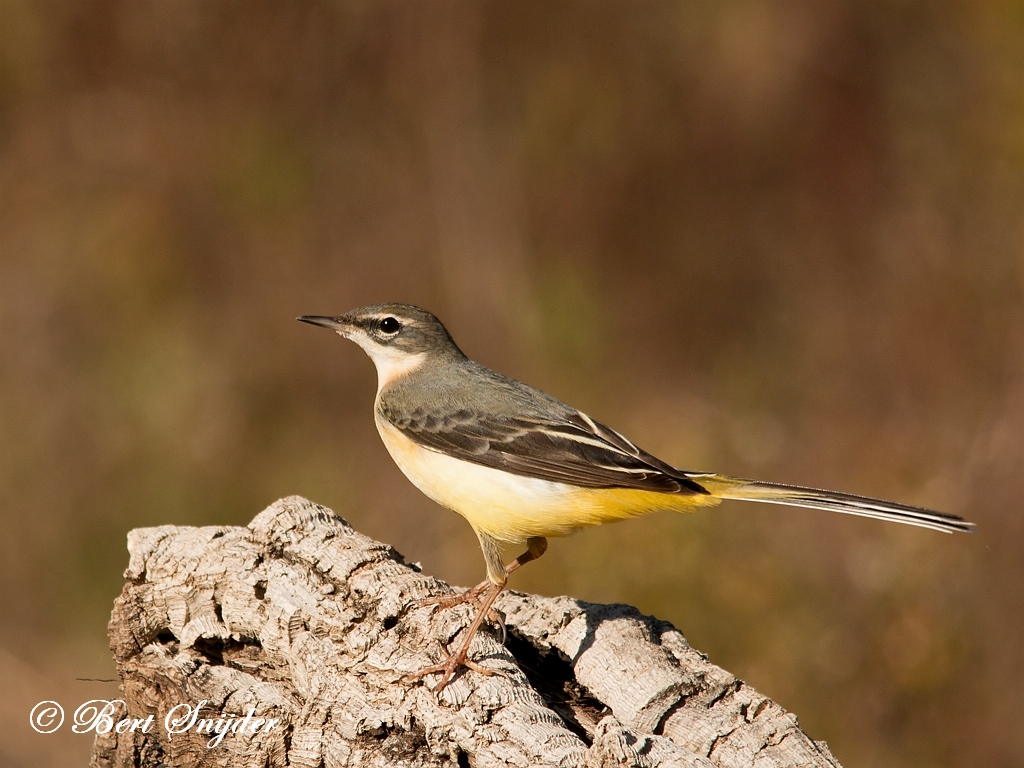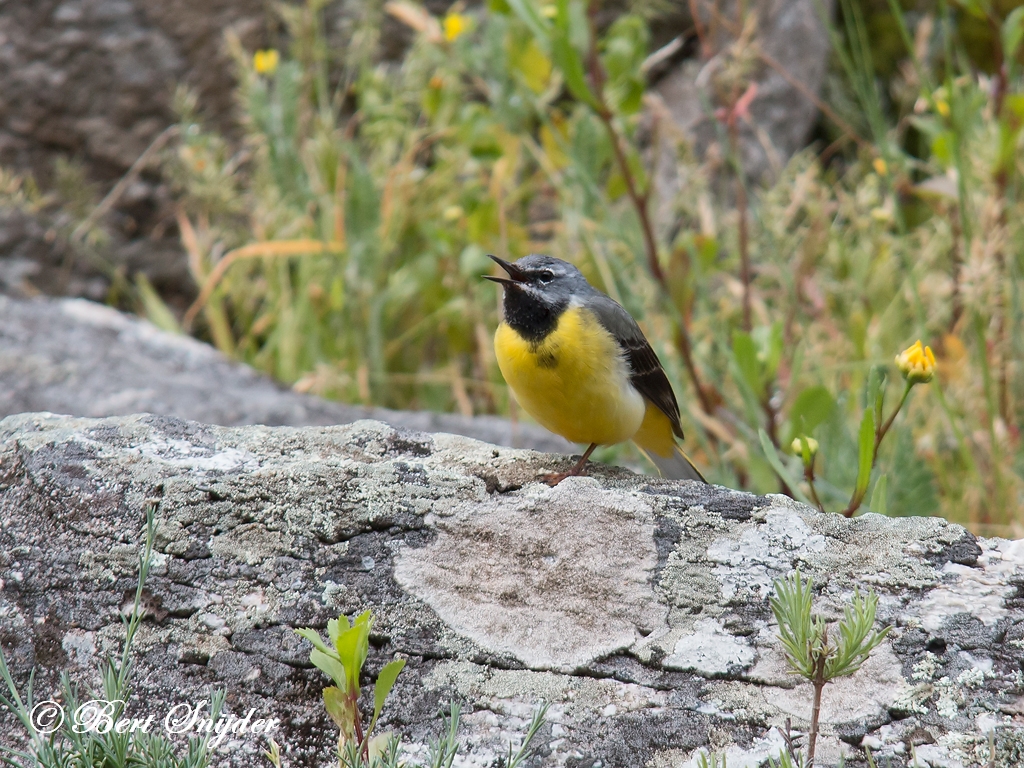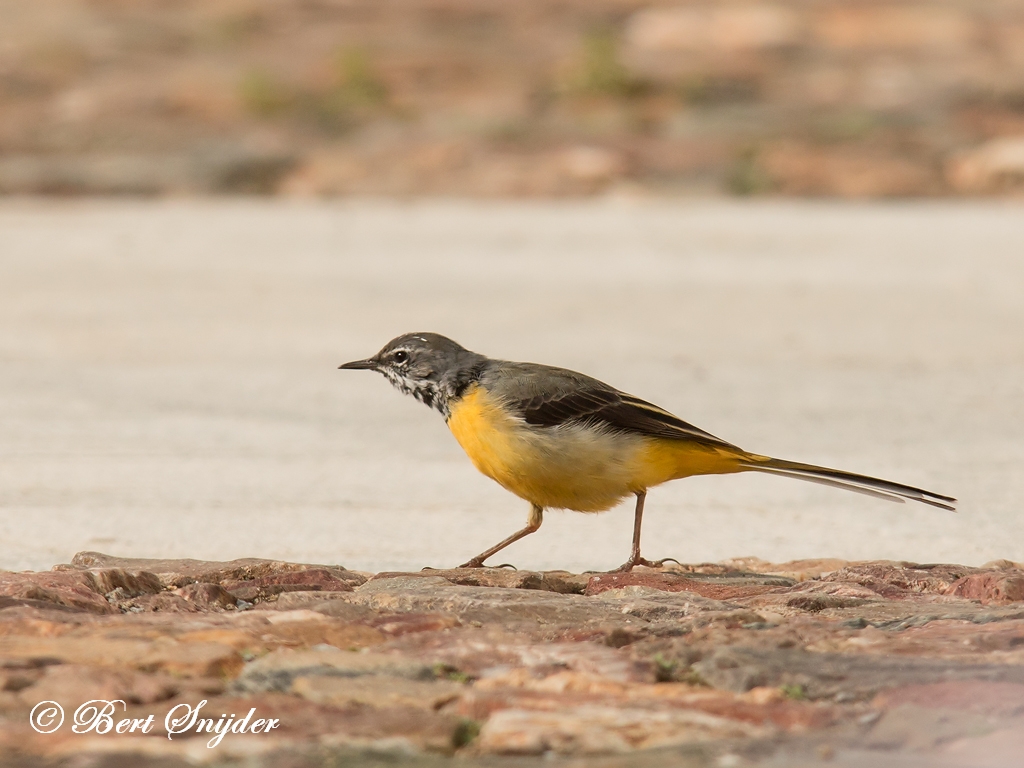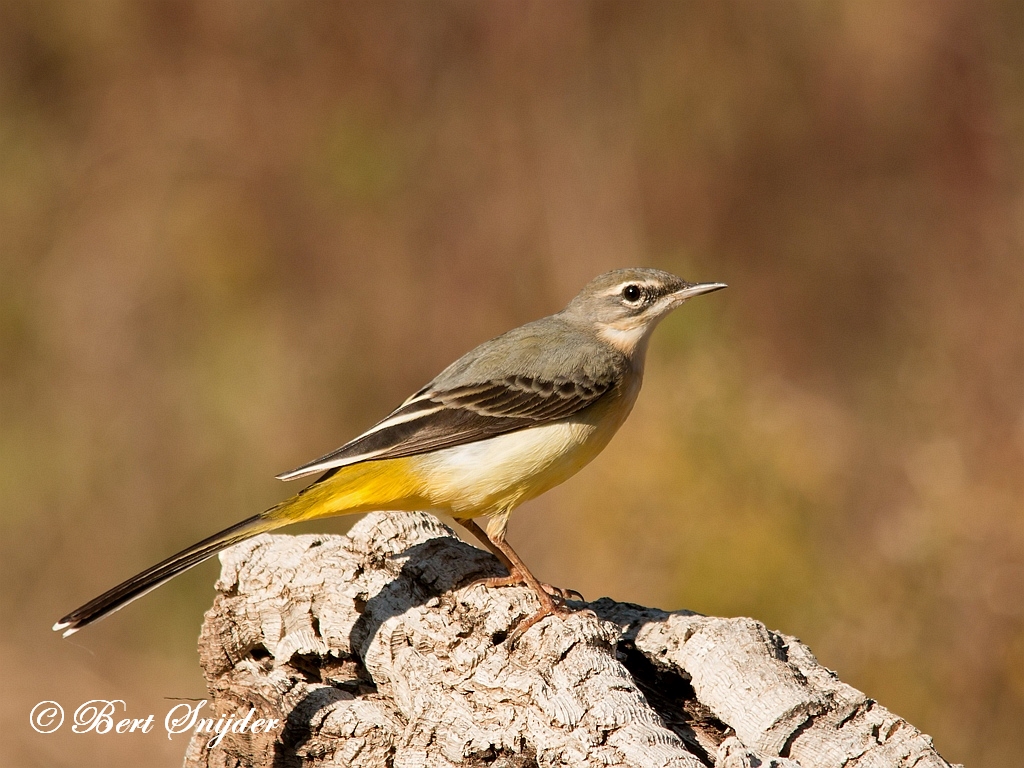Grey Wagtail, Grote Gele Kwikstaart, Gebirgsstelze, Alvéola-cinzenta, Lavandera Cascadeña
Spotted at Monte Horizonte in the Alentejo region of Portugal. Grey Wagtail sound
The Grey Wagtail (Motacilla cinerea) is a small member of the wagtail family, Motacillidae. The species looks similar to the Yellow Wagtail but has the yellow on its underside restricted to the throat and vent. Breeding males have a black throat. The species is widely distributed, with several populations breeding in Europe and Asia and migrating to tropical regions in Asia and Africa. They are usually seen on open marshy ground or meadows where they walk solitarily or in pairs along the ground, capturing insects that are disturbed. Like other wagtails, they frequently wag their tail and fly low with undulations and they have a sharp call that is often given in flight.

More photos at the bootom of this page:
This slim wagtail has a narrow white supercilium and a broken eye ring. The upperparts are grey and the yellow vent contrasting with whitish underparts makes it distinctive. The breeding male has a black throat that is edged by whitish moustachial stripes. They forage singly or in pairs on meadows or on shallow water marshes. They also use rocks in water and will often perch on trees. They have a clear sharp call note and the song consists of trills.
The bird is widely distributed across the Palearctic region with several well marked populations. The nominate form (includes caspica of Iran, Turkey and the Caucasus) is from western Europe including the British Isles, Scandinavia and Mediterranean region. Race melanope, which is not well separated from the nominate subspecies, is described as the population breeding in eastern Europe and central Asia mainly along the mountain chains of the Urals, Tien Shan and along the Himalayas. They winter in Africa and Asia. Race robusta breeds along the northeastern parts of Asia in Siberia extending to Korea and Japan. These winter in Southeast Asia. Island forms include patriciae of the Azores, schmitzi of Madeira and canariensis of the Canary Islands.
They sometimes occur on the islands to the West of Alaska but have been known to occur further south in California as a vagrant.





Other synonyms:
Afrikaans: Gryskwikkie
Asturian: Xingalrau
Breton: Ar gannerez-dour
Catalan: Cuereta torrentera, Cueta groga, Xàtxero cendrós
Catalan (Balears): Xàtxero cendrós
Valencian: Cueta groga
Cebuano: bangkiyod
Czech: Konipas horský
Welsh: Brith y fuches lwyd, Siglen las, Siglen llwyd, Siglen lwyd, Tinsigl lwyd
Danish: Bjergvipstjert
German: Bergstelze, Gebiergsstelze, Gebirgsstelze, Gebirgstelze
Emiliano-romagnolo: Buvarena
English: European Gray Wagtail, European Grey Wagtail, Gray Wagtail, Grey Wagtail
Esperanto: montarmotacilo
Spanish: Lavandera Cascadeña, Lavandera de cascada
Estonian: Jõgivästrik
Basque: Buztanikara horia, Buztinikara hori, Cuereta torrentera
Finnish: Virtavästäräkki, Vuorivästäräkki
Faroese: Áarerla
French: Bergeronnette boarule, Bergeronnette des ruisseaux
Frisian: Winterboumantsje
Irish: Glasóg cheannliath, Glasóg Liath
Gaelic: Breac Bain tighearna, Breacan-Baintighearna
Galician: Cuereta torrentera , Lavandeira real
Manx: Skibbag ny mulleeyn, Ushag Ghlass
Croatian: Gorska Pastirica, Gorska pliska
Hungarian: Hegyi billegeto, Hegyi billegetõ
Indonesian: Entut leuncang, Kicuit batu
Icelandic: Straumerla
Italian: Ballerina gialla
Japanese: kisekirei, Ki-sekirei
Karelian: Keldavästäräkki
Latin: Calobates cinerea, Motacila cinerea, Motacilla boarula, Motacilla caspica, Motacilla cinerea
Lithuanian: Kalnine kiele
Mamasa: bi lolo
Malay: Burung Pipit Batu, Kedidi Kepala Kelabu
Maltese: Zakak tad-Dell
Dutch: Grote Gele Kwikstaart
Norwegian: Alpeerle, Gråerle, Vintererle
Napoletano-calabrese: Cudàstra
Polish: Pliszka cytrynowa, pliszka górska
Portuguese: alvéola cinzenta, Alvéola-cinzenta
Romansh: Ballacua da muntogna
Russian: Gornaya Tryasoguzka
Scots: Breac bain tighearna
Northern Sami: Dálvebeštor
Slovak: Trasochvost horský
Slovenian: siva pastirica
Albanian: Bishtatundësi i malit
Serbian: Gorska pliska, planinska pastirica, planinska pliska
Swedish: Forsärla
Swahili: Tikisa Kijivu
Travel Birdwatching Holiday Alentejo, Vacation Portugal for birders to see birds on your trip.